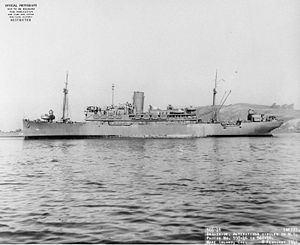Construction started 1932 Length 136 m | Laid down 1932 Launched 1932 | |
 | ||
Name SS Quirigua (1932–41, 1946–58) USS Mizar (1941–46)SS Samala (1958–64) Acquired by bareboat charter, 2 June 1941 Commissioned USS Mizar (AF-12),14 June 1941 | ||
USS Mizar (AF-12) was a United Fruit Company cargo and passenger liner that served as a United States Navy Mizar-class stores ship in World War II.
Contents
Building and pre-war service
Bethlehem Shipbuilding Corporation of Quincy, Massachusetts built the ship as SS Quirigua for United Fruit Company in 1932. She was one of six UFC sister ships driven by turbo-electric transmission. The United States Postal Service subsidised the building of the six ships, which served the USPS as mail boats.
United Fruit placed Quirigua on express liner services between Central America and New York. She normally carried up to 95 passengers to ports in Central America and then would return to the United States with passengers and a cargo of refrigerated bananas and miscellaneous cargo.
US Navy service
The US Navy bareboat chartered Quirigua through the Maritime Commission on 2 June 1941 under Public Law 101, 77th Congress and Executive Order 8771. Brewer's Drydock Co. of Staten Island, New York converted the ship for Navy service by adding one single 5"/38 caliber gun, four 3"/50 caliber guns for anti-aircraft (AA) and anti-submarine use and up to eight Oerlikon 20 mm cannon AA guns. She was renamed Mizar and commissioned into the US Navy on 14 June 1941, commanded by Cmdr E.D. Walbridge.
With some modification Mizar was able to carry a number of troops as well as her refrigerated stores. She was crewed by Merchant mariners plus a team of United States Navy Armed Guard sailors to man her guns. The Guards were assisted by the "civilian" crew and all took equal risk of being sunk by submarine or aircraft; but only the Armed Guard were judged eligible for G.I. Bill benefits.
For the early part of 1942 Mizar sailed the western Atlantic from a number of US East Coast ports, supplying bases and ships from Iceland to the Virgin Islands.
Pacific Theater operations
Mizar was then modified with more berthing and more 20 mm AA guns before departing from Norfolk, Virginia, 10 June 1942 with task force TF 39, carrying some of the 1st US Marine Division who were to take part in the invasion of the Solomon Islands. The force transited the Panama Canal on its month-long voyage to Wellington, New Zealand.
Continuing in the southwest Pacific as part of Service Force, US 7th Fleet, she operated initially from Australian ports supporting the successful Australian and American campaign to stop the Japanese on New Guinea. Mizar made seven unescorted voyages to San Francisco, California, between 12 October 1942 and 9 February 1945 to get fresh meat, fruit, vegetables, dairy products and eggs to supply advanced bases and combatant ships. When not making these crossings of the Pacific Ocean she normally worked between Brisbane and Milne, New Guinea.
After the advance of US and Allied Forces in the Pacific she extended her Australian-based service to the Admiralty Islands in May 1944 and anchored in Leyte Gulf in the Philippines on 18 February 1945. She continued carrying men and supplies throughout these areas until 4 January 1946.
End-of-war duties
Steaming eastward she reached San Francisco 25 January but soon received orders to go to the US East Coast. Previewing a return to civilian status, en route she took bananas for the United Fruit Company from Quepos, Costa Rica to Charleston, South Carolina.
Mizar averaged over 5,000 miles a month in World War II and received four battle stars for her service. She was decommissioned as a naval vessel at Baltimore, Maryland and returned to the United Fruit Company on 1 April 1946, and struck from the Navy list of active ships on 17 April.
Post-war civilian service
United Fruit restored the ship's pre-war name Quirigua to her. In 1958 United Fruit transferred Quirigua and her sisters Talamanca and Veragua to its British subsidiary Elders and Fyffes. Quirigua was renamed SS Samala after an earlier Fyffes ship of the same name. She was scrapped in 1964.
Other Ships in the Mizar class
Other converted "reefer" ships
The older passenger and refrigerated ships acquired from United Fruit in 1942, USS Pastores (AF-16) and USS Calamares (AF-18) were built in 1912 and 1913 and were of a different class from USS Mizar. They had been requisitioned in World War I and then returned to United Fruit The converted "reefers" USS Uranus (AF-14), USS Roamer (AF-19) and USS Pontiac (AF-20) were former Danish refrigerated ships requisitioned by the US Maritime Commission in 1942.
